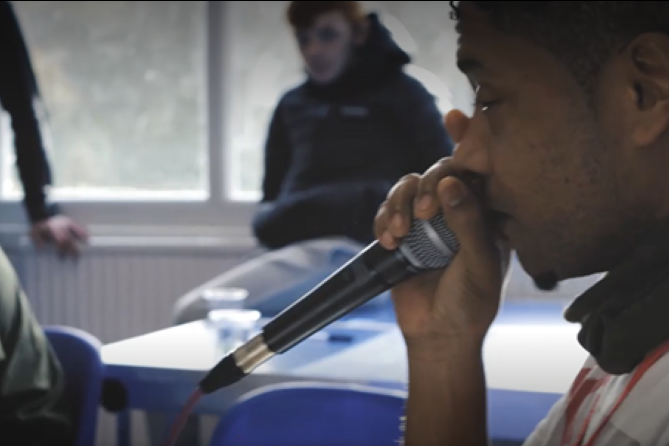Background
Torfaen Pupil Referral Unit (PRU) is a specialist provision for pupils with additional learning needs. A mixed group of key stage 3 & 4 learners took part in the project over two sites.
Attendance and behaviour can often be a challenge with this group of learners. The aim of the project was to explore how an investigation into Cynefin and belonging could improve the learner’s attendance, engagement and develop their creative habits of mind. Staff were curious to see how collaborating with diverse creative professionals might support this aim.
Activity
The project was co-delivered by the classroom teachers responsible for the Humanitie and Expressive Arts AOLE’s and Creative Practitioner, Joseph Roberts. Additional creative practitioners were brought in to support the project. The project began with a carousel of introductory workshops facilitated by ethnically diverse artists from the local Hip Hop community. Learners rotated throughout the day, gaining the opportunity to DJ, Beatbox and create their own piece of graffiti.
On the first day of the project, the building was bouncing with baselines. The diverse conversations about culture and the origins of hip hop have had a huge legacy, exposing our learners to a raft of fantastic creative elements
Throughout the day, the learners had the opportunity to explore what the terms Cynefin and belonging meant to them now, and what they might mean in the future. They also had several conversations around the relationship between music and art. The learners were also intrinsically interested in the backgrounds of the creative practitioners and how they 'got so good' at what they did.
From this initial day a series of further workshops developed, including, lyric writing, creating and playing music using Bandlab, and exploring the use of graffiti. Learner voice was an essential part of the project, with learners following their particular interests. At every part of the project there was continuous conversations between the learners, teachers, and the creative practitioner to ensure that each phase of the project was in line with its aims and met the needs and interests of the learners.
We have seen how powerful it is to utilise the arts to encourage learners to consider what is the most effective way to 'tell a story', or to represent, document, share and celebrate the personal, social and cultural identities found in our community, in Wales and in the wider world.

Impact
From the outset of the project, staff noticed a clear impact on the engagement of learners and their attitude to learning. They were particularly surprised by how the confidence of the learners increased.
Staff felt that the project allowed them to explore diversity, culture and perspectives in a creative and innovative way and offered an opportunity to re-evaluate their curriculum. As a result, they are now more confident in discussing issues around diversity, race, culture, society and belonging. They have also seen the benefit of exposing their students to a more diverse range of Black and minority ethnic voices and narratives and are looking to embed this in the future.
The project has supported staff in thinking about how to plan collaboratively for project-based learning allowing students to 'play' and experiment with different materials, resources, tools and technologies in art, and music and therefore develop their ideas.
Students who did not want to come to school, came to school on time. Students who are painfully shy or have low self-esteem spoke on camera or had a go at beatboxing. We had students who felt they were not 'arty' but found that they had skills they did not realise.

It has set a 'benchmark' for us as a centre to aspire to as we plan for not only academic progress but for authentic and meaningful opportunities and experiences. This will certainly involve exploring the more focused use of trips, visits and bringing in people from the wider community to share their stories and skills with our learners.

